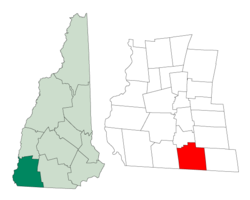Fitzwilliam, New Hampshire
| Fitzwilliam, New Hampshire | ||
|---|---|---|
| Town | ||

Meeting House and Common
|
||
|
||
 Location in Cheshire County, New Hampshire |
||
| Coordinates: 42°46′50″N 72°08′30″W / 42.78056°N 72.14167°WCoordinates: 42°46′50″N 72°08′30″W / 42.78056°N 72.14167°W | ||
| Country | United States | |
| State | New Hampshire | |
| County | Cheshire | |
| Incorporated | 1773 | |
| Government | ||
| • Board of Selectmen | Susan Silverman, Chair Nancy Carney Christopher Holman |
|
| • Town Administrator | Debbie Favreau | |
| Area | ||
| • Total | 36.0 sq mi (93.3 km2) | |
| • Land | 34.6 sq mi (89.7 km2) | |
| • Water | 1.4 sq mi (3.7 km2) 3.91% | |
| Elevation | 1,145 ft (349 m) | |
| Population (2010) | ||
| • Total | 2,396 | |
| • Density | 67/sq mi (26/km2) | |
| Time zone | Eastern (UTC-5) | |
| • Summer (DST) | Eastern (UTC-4) | |
| ZIP code | 03447 | |
| Area code(s) | 603 | |
| FIPS code | 33-26500 | |
| GNIS feature ID | 0873597 | |
| Website | www.fitzwilliam-nh.gov | |
Fitzwilliam is a town in Cheshire County, New Hampshire, United States. The population was 2,396 at the 2010 census. Fitzwilliam is home to Rhododendron State Park, a 16-acre (6.5 ha) grove of native rhododendrons that bloom in mid-July.
First granted as Monadnock No. 4 in 1752 by Colonial Governor Benning Wentworth, this was one in a line of eight towns settled by Scottish colonists. Incorporated in 1773 by Governor John Wentworth, the town was named for his cousin, William Fitzwilliam, 4th Earl Fitzwilliam. Two early grantees in Fitzwilliam were Matthew Thornton, signer of the Declaration of Independence, and James Reed, who would lead the 3rd NH Regt. at Bunker Hill. The community claims one of the oldest granite quarries in New Hampshire. Other industries included wood-working and yarn-making. The railroad would enter in 1848.
Fitzwilliam's picturesque common, together with twelve antique houses that surround it, are listed on the National Register of Historic Places.
...
Wikipedia

